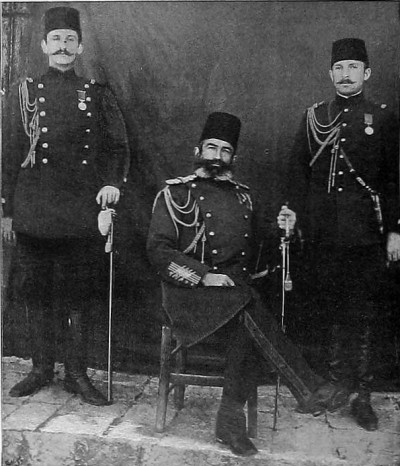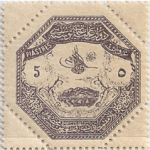ALBUM – view my Ottoman Occupation of Thessaly album
Fast Facts
Region: Ottoman Empire
Group: Occupations in the Ottoman Empire
Classification: Military Occupation (Ottoman)
Prior Regime: Kingdom of Greece
Key Dates:
1897, Apr 12 – Ottoman Empire forces defeat Greek army and march to occupy the Thessaly region.
1897, May 20 – Ceasefire agreed in Thessaly
1897, Sept – Peace agreed between Greece and the Ottomans
1897, Dec 4 – Treaty of Constantinople signed
1898, May – Ottoman Army leaves Thessaly
Following Regime: Kingdom of Greece
Scott Catalogue: (Turkey, Military Stamps) #M1-M5
Pick Catalogue: none
History

The Greek army retreated to the mainland, where it next attempted to advance northwards into Thessaly and Epirus.
 The Greek army, consisting of two divisions, was unable to capitalize on its early incursions across the Macedonia – Thessaly border and suffered defeats in several battles around the mountain passes between Macedonia and Thessaly south of Mount Olympus. The Greek front collapsed on 12 April 1897, and the Greek forces began to retreat into the Thessalonian plain. Within two weeks and with little resistance, the Turkish army controlled all of Thessaly.
The Greek army, consisting of two divisions, was unable to capitalize on its early incursions across the Macedonia – Thessaly border and suffered defeats in several battles around the mountain passes between Macedonia and Thessaly south of Mount Olympus. The Greek front collapsed on 12 April 1897, and the Greek forces began to retreat into the Thessalonian plain. Within two weeks and with little resistance, the Turkish army controlled all of Thessaly.
Greece appealed to European powers and peace was agreed by both sides in Sept 1897. The final agreement, the Treaty of Constantinople, was signed on 4 Dec. 1897 and Thessaly would be largely returned to Greece with changes in the pre-war border in which portions of northern Thessaly would be ceded to the Ottoman Empire. Additionally Greece was forced to pay heavy reparations, which put high strains on the Greek government requiring them to submit to international supervision.
The Ottoman troops withdrew from Thessaly in May of 1898.
Stamps
 ALBUM
ALBUM
During their brief occupation, five stamps were issued for Turkish occupation forces in Thessaly on 16 April, 1898.
The stamps were octagonal and were perforated on all eight sides. The common design featured the toughra of the Sultan and, in the lower part of the central vignette, a view of the railway bridge at Larisa over the river Pinios. 300,000 stamps in the series were printed and the last known date of usage is 9 June 1898.
After the Ottoman army withdrew from Thessaly, the remainders of these stamps were sold to two stamp dealers in Paris and Vienna.
Banknotes
none
Links
Greco-Turkish War from Wikipedia
Greco Turkish War – Foundation of the Hellenic World
The Hellenic Ottoman War of 1897





The stamps were not produced for the army, but for the public in the occupied territory. Not one single cover is known, that coud be seen as military used!
Hello Dr Birken
These stamps are an enigma to me. The are classified as Military stamps in the catalogs I have seen. The only literature I am aware of is from the British Philatelist, May 1898, which indicates that the stamps were produced as the Ottomans were evacuating the area, primarily as a “tangible evidence of the occupation”. It talks about the speculative nature of the stamps.
If you have any good published literature on these stamps, please point me in the right direction.
Michael
The dates of Greco-Turkish wars after the 1897, April 12, are incorrect….about 100 years off .
1897, Apr 12 – Ottoman Empire forces defeat Greek army and march to occupy the Thessaly region.
1997, May 20 – Ceasefire agreed in Thessaly
1997, Sept – Peace agreed between Greece and the Ottomans
1997, Dec 4 – Treaty of Constantinople signed
1998, May – Ottoman Army leaves Thessaly
Thank you for visiting DCStamps, and taking the time to make me aware of errors in dates. I have corrected the dates.
Michael